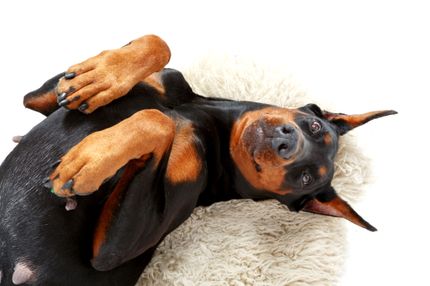Facts & Origin
History and origin of the Golden Akita Retriever
The Golden Akita Retriever, a mix of Akita Inu and Golden Retriever is a designer breed that is growing in popularity. Akitas were originally bred in Japan, are namesake of Akita Prefecture, and were used to hunt bears, wild boar, and deer. Golden Retrievers have their roots in Scotland, where they were bred in the 19th century as hunting and retrieving dogs. United, they make the Golden Akita Retriever, a loving and loyal family dog.
On the whole, the Golden Akita Retriever is an impressive, loving and loyal dog that, with the right owners and regular care, makes a perfect family pet.
| Alternate Name | - |
| Origin | Japan - UK |
| Life expectancy | 10 - 15 years |
| Care requirements | high-maintenance |
| Activity level | average to high - average |
| FCI group | not recognised |
| AKC group | not recognised |
| KC group | not recognised |
More Akita Inu mixes
More Golden Retriever mixes
Attitude, character and temperament of the breed
Possible character traits of the Golden Akita Retriever.
The Golden Akita Retriever is a very lovable, friendly and loyal dog. It has a remarkable independence from the Akita Inu breed and at the same time is very adaptable and learnable due to the Golden Retriever side. They are very active and energetic, so they need a lot of physical activity and mental stimulation.
They tend to be a 'one person dog', meaning that they form a particularly close relationship with one particular person in the family. It may be that the Golden Akita Retriever has inherited the prey hunting traits of the Akita Inu and therefore may not always get along with other pets. Proper socialization from a young age is critical here.
The Golden Akita Retriever is characterized by his balance, loyalty and strength. He is a good match for active people or families who have time for extensive walks and games. Thanks to his intelligent nature, he is very capable of learning and responds well to positive reinforcement.
Essential characteristics of the Golden Akita Retriever
- Temperament: Loyal, friendly, alert
- Size: Medium to large, 50-75 cm
- Weight: 30-60 kg
- Coat and color types: Thick, straight coat in colors varying from light gold to jet black.
- Grooming requirements: Moderately high, regular brushing required
- Health Risks: Hip dysplasia, skin allergies, heart disease, eye problems.
The Golden Akita Retriever is not only a beautiful animal, but also a loving and loyal companion. With proper care and training, these dogs can be a great member of the family.
Character
Care and health
This hybrid dog needs regular grooming to keep his coat healthy and shiny. Thorough brushing once or twice a week will help remove dead hair and prevent matting. During molting periods, daily grooming may be required.
In terms of health, Golden Akita Retrievers can inherit genetic problems from both parent breeds. Potential health problems include hip dysplasia, skin allergies, heart disease and eye problems. Regular health checks at the vet and a balanced diet can help minimize these risks.
Breeding the Golden Akita Retriever
Cross breeding of Akita Inu and Golden Retriever should be done by responsible breeders who pay attention to health problems, personality and family history of both parents. It is important that they produce healthy and socialized puppies that meet the physical and mental requirements of this breed.
What does this mixed breed look like?
The Golden Akita Retriever is a large dog. He reaches a height of about 52 to 64 cm and weighs between 25 to 40 kg. Its appearance is a mixture of the Akita Inu's strength and the Golden Retriever's friendly charisma. The body stature is robust and the eyes are usually dark and radiate a special warmth.
The coat of the Golden Akita Retriever is usually dense and wavy, similar to that of the Golden Retriever, but can also be straighter and harder, as in the Akita Inu. Coat colors vary and range from cream to gold to red and black.
Known Diseases
Sebadenitis
Sebadenitis is a skin disease in dogs that leads to inflammation of the sebaceous glands. This can lead to dandruff, hair loss and itching.
Hypothyroidism
Hypothyroidism is a condition in dogs where the thyroid gland does not produce enough thyroid hormones. This can lead to a slowed metabolic rate, weight gain, fatigue, hair loss and other symptoms.
Hip dysplasia (HD)
Hip dysplasia (HD) is a genetic condition in dogs where the hip joint is not shaped properly. This leads to pain, stiffness and restricted movement.
congenital vestibular syndrome
hereditary disease of the inner ear
Spondylosis
pathological changes in the vertebral bodies and intervertebral discs
Arthrosis
Osteoarthritis is one of the most common diseases in dogs. Dogs have an innate, strong urge to move
Elbow dysplasia (ED)
Elbow joint dysplasia is a chronic disease complex of the elbow joint of fast growing dog breeds.
Epilepsy
Definition: Dog has epilepsy if, for example, at least two epileptic seizures occur more than 24 hours apart.
Cataract
Cataracts are still one of the most common causes of blindness, even in dogs.
Progressive Retinal Atrophy (PRA)
Progressive retinal atrophy (PRA) is a slowly progressive death of the retina in dogs.
FAQ
-
Mixed breeds of a Golden Retriever and an Akita Inu reach sizes that vary between these two breeds.
-
The coat color can vary from light gold to black.
-
The Golden Akita Retriever is very loyal, playful and affectionate. They are intelligent and learn quickly, but due to their soft and lovable nature, they do not always want to implement.
-
Yes, this hybrid breed is very suitable for families, as it is very affectionate and playful and likes to be with children.




















